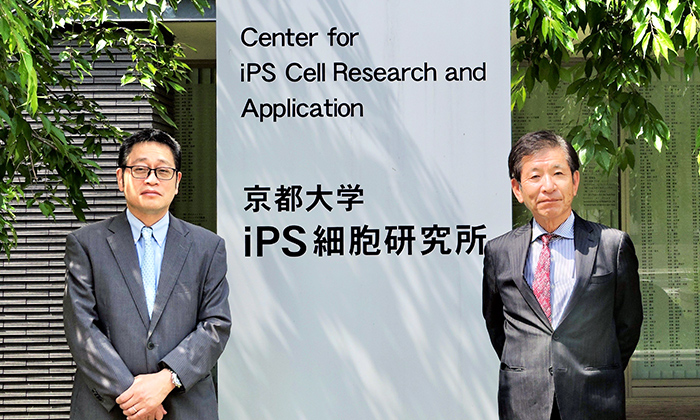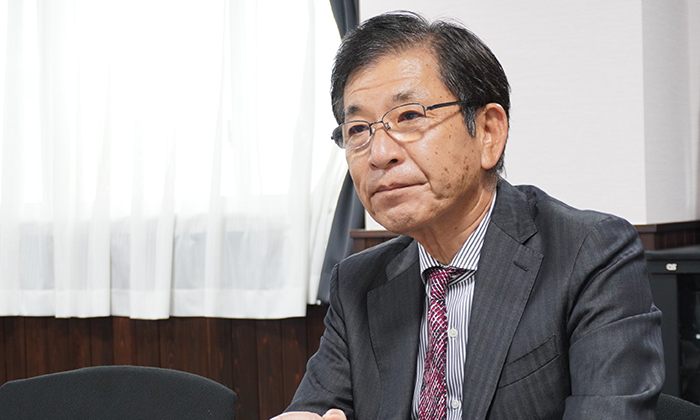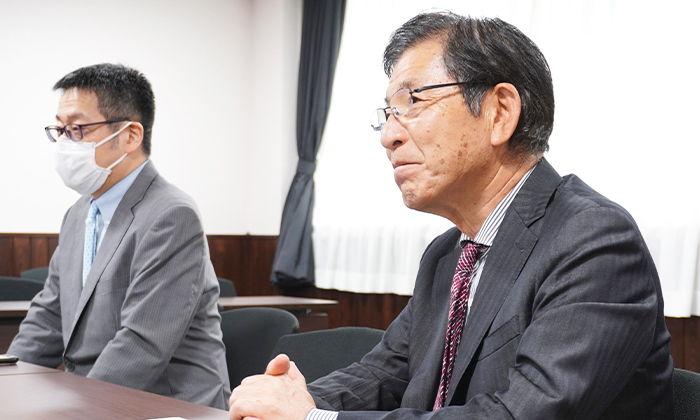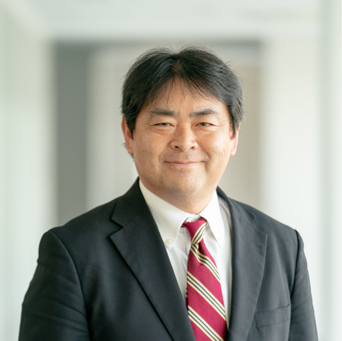Contact UsCONTACT
Please feel free to contact us if you have any questions or concerns.
Inquiry FormStories
STORIES
SERIES EMBARK

Founded in September 2019, Rege Nephro Corporation aims to commercialize a technology to suppress the progression of kidney disease by transplanting renal progenitor cells produced from human iPS cells under the capsular membrane. The company intends to tackle chronic kidney disease (CKD), which is said to exist among some 13 million people in Japan alone, with a new treatment method that does not rely on artificial dialysis or kidney transplantation. The company received investment from Kyoto University Innovation Capital (Kyoto-iCAP) in June 2020. We interviewed Kenji Osafune, founder and member of the board and chief scientific advisor (professor at Center for iPS Cell Research and Application), and Toshihiro Ishikiriyama, president and representative director, about the business and its growth strategy.
(Interviewer: Hidenori Takahashi)
After graduating from Kyoto University School of Medicine in 1996, I worked as a nephrologist for four years and have been studying kidney regeneration from 2000 until today. When I graduated, I wondered what department I would go into. I wanted to help patients by regenerating non-regenerating kidneys because kidney disease will become more important in the world as the number of patients increases and the only curative treatment is kidney transplantation due to the shortage of donors. At that time, regenerative medicine did not attract much attention because there were no iPS cells like today. I was particularly interested in the fact that kidneys, once damaged by disease, cannot be restored to their original state, and the disease will only continue to progress.
I had been conducting joint research with pharmaceutical companies, but they would not cooperate unless the product could be commercialized in the next two or three years. In order to start a business, I needed to find a competent president, so I consulted with a well-connected acquaintance who introduced me to President Ishikiriyama.

From a societal perspective, there are approximately 13 million chronic kidney disease patients in Japan. The proportion of patients is estimated to be one in seven adults, and it has been called the new national disease. Because the condition progresses gradually, more than 340,000 patients receive dialysis therapy. The annual medical cost for dialysis is 1.5 trillion yen, accounting for about 5% of total medical costs. Worldwide, there are approximately 850 million patients. We have many social, economic, and medical problems, and we want to solve them. At this point, there is almost no cure. I am still responsible for outpatient care, but patients basically have either the condition as it is or it gets worse. Our immediate goal is to stop the progression of renal failure and prevent the creation of new dialysis patients through cell therapy, for which we plan to begin clinical trials in 2023.
When I was a graduate student, I tried to find kidney stem cells, and after about five years, I was able to prove for the first time that there were stem cell-like cells called nephron progenitor cells, which are the source of glomeruli and tubules, in the fetal kidney. Later, in 2008, I was hired by the Kyoto University iPS Cell Institute to create nephron progenitor cells from human iPS cells. There are two research directions. One is to create a complete kidney and transplant it into dialysis patients. The other is to reduce kidney damage. For the latter, in 2015, we discovered that cell therapy, in which nephron progenitor cells are transplanted around the kidneys of mice, can help treat kidney damage. Now we can make all kinds of cells from iPS cells; we can make two-dimensional sheets or clumps of cells, but it still takes time to make a large organ like a kidney, which has 30 different cell types and a complex structure. We decided to turn our attention to cell therapy because it would be much faster to solve the medical and economic problems.
To enter clinical trials, quality and safety must first be assured. This is not so difficult in the case of small molecules, but in the case of cells, the process of assuring quality and safety is expensive. In the case of cells, however, the process of ensuring quality and safety is expensive, because we must invest the necessary human resources, equipment, and talent. Efficacy is another issue, but there is now considerable evidence that it may be effective in humans as well. Then again, the biggest challenge is to ensure quality and to be able to manufacture in large quantities.
iPS cells can change into various types of cells, but they do not change 100%. Some remain unchanged. It is said that if some remain in the body, they may become tumors. A highly accurate culture method is necessary to ensure that nothing remains completely. The minimum line is that there should be no side effects even if the transplantation is not effective for the patient. We need to ensure that.

Samples will be manufactured for non-clinical testing, and non-clinical and safety studies will be conducted. That is our goal for 2022. We are trying to complete the manufacturing process to achieve our goal. Clinical trials are scheduled for 2023. Although there are some financial challenges, we expect to have a high degree of certainty that we will be able to achieve the technology by that point. We are the only company in the world that is working on cell therapy for chronic kidney disease using nephron progenitor cells derived from iPS cells. Kidney disease is a very large market, so it is very expensive to develop something. First, we will try to apply it to humans, aiming to inhibit the progression of chronic kidney disease that develops in kidney transplant patients. After that, we would like to expand our portfolio of development products by developing them for general chronic kidney disease and then further expanding the range of targeted renal diseases.
Dr. Osafune was the first to identify nephron progenitor cells, and he has created a cell line that is efficient and closest to the nephron progenitor cells of the human kidney. Using these nephron progenitor cells, we will first proceed with cell therapy. Next, we will enhance their effectiveness by genetic modification. Furthermore, we aim to use nephron progenitor cells to repair the kidney in a sense. If we can get to the point of repair, Dr. Osafune believes that we can not only stop the progression of the disease, but also improve the condition of the kidneys. In addition, he envisions using nephron progenitor cells to evaluate nephrotoxicity in drug discovery. Ultimately, he also envisions reconstructing the kidney. Nephron progenitor cells are the main part of the kidney, but Dr. Osafune has also developed and applied for a patent for other progenitor cells, progenitor cells that form the basis of the collecting ducts, so we are combining those types of cells.
So far, we have focused on gathering human resources for R&D, but when it comes to commercialization, we will need a more diverse workforce. I think the challenge is to gather good human resources. For example, let's say we start negotiations with an overseas company. Then, there are contracts, patents, and business plans for commercialization that need to be created. You also need to know the global market trends. The human resources you need will change qualitatively over time, and to reach 850 million patients, you will also need such human resources. I used to work for a large pharmaceutical company, so I worked in a situation where we had all the human resources we needed. Now that I am in a venture company, I feel the importance of human resources.
There are two reasons; one is Dr. Osafune. I saw that he was working diligently to somehow help patients suffering from kidney disease, and I wanted to help in any way I could. The other reason is that I have benefited from the pharmaceutical and medical industries, and I wanted to return the favor.

After all, I was able to get funding. Not all universities have something like Kyoto-iCAP, so if I had not worked at Kyoto University, I might not have been able to start my business. I was also introduced to various human resources. I was able to expand my network.
We were introduced to many different companies. We were also introduced to companies that were having the same difficulties as ours and heard from various people how they solved their problems. We also have a person from Kyoto-iCAP as an outside director, so we receive detailed advice and consultation on management issues. I strongly feel that they are taking the stance of nurturing companies. A startup like ours is full of challenges, so we cannot move in the right direction without a variety of support. When raising funds, we are sometimes introduced to venture capital (VC) firms, and since we are introduced to Kyoto-iCAP, the VC firms respond differently. There are few places that will provide funding or support when a business is in the egg stage. I feel that if Kyoto-iCAP does not at least provide funding, other VCs, companies, and banks will not follow.
I thought the only way was to start my own business, so I tried. With joint research with a company, you can only do sure things, and it is difficult to do anything challenging or big. For that reason, entrepreneurship is the only way. I want to demonstrate that what cannot be done through joint research can be realized by starting a business in this way.
(Interviewed in June 2021. Affiliations, positions, etc. are as of the time of the interview)
Chronic kidney disease (CKD) is a social problem in many countries. Despite the enormous amount of money being spent on medical care, there is still no effective treatment for CKD. Moreover, the number of CKD patients is increasing due to the aging of the population and other factors. The goal of Rege Nephro is to develop a treatment technology that will allow patients to regain healthy kidneys. It is based on research results discovered by Professor Kenji Osafune, a world pioneer in the field. The company is led by Toshihiro Ishikiriyama, a former executive at a megapharma company. His former subordinates have regrouped at Rege Nephro and are trying to bring about innovation.

Osami Kono

Rege Nephro Co., Ltd. Website
Please feel free to contact us if you have any questions or concerns.
Inquiry Form